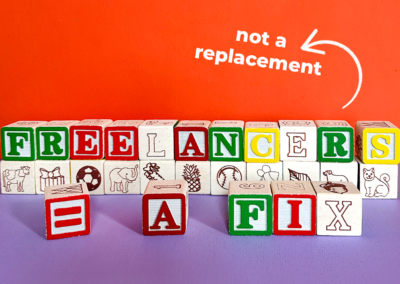As I began to imagine the impact that We Are Rosie could have on the world of work, I knew that finding the brightest, most passionate, and most innovative minds was a critical piece of the puzzle. I also knew it might not be easy—this business started with just a flicker of an idea and without any outside investment to bring it to life
How could I attract and retain the best team possible? It kept me up at night. In our first year of business, as we grew to a mighty team of eight people, I thought a lot about the benefits we offered, including medical, dental, vision, retirement plans, professional development, and of course, PTO. Having benefits that cared for our team as whole human beings was important, especially as we set out to change the way work happens (not easy).
I leaned on my own experience working at tech start ups and presumed that unlimited PTO was a no-brainer for We Are Rosie. It’s what all the cool companies had done, right? It seemed like the right decision at the time, as it fell in line with our core value of TRUST. We trust the people who work here to do their jobs. We trust them to let us know when they need to take time away. And we trust them to figure out what work/life harmony means for them.
Well, there were some big flaws in my thinking, and they would become evident once the pandemic started.
When burnout culture happens by accident
We Are Rosie came on the scene with wild growth, right out of the gates. Amidst all the uncertainty of the pandemic, we tripled in size and revenue in 2020, after doubling and tripling in the two years prior. The team was working harder than-ever. We saw the impact we were making and it felt easy to pour ourselves into the mission, especially as many of us needed a distraction from everything happening in the world. But the downside of having a really passionate team, a really meaningful mission, and a company that is absolutely at the right place at the right time was burnout.
I started to see signs of burnout on my team within months of the pandemic. They were exhausted; they were anxious; they were homeschooling; they were caring for sick family members; they were missing funerals, weddings, births. It was A LOT.
I talked to the team to understand how we could better support them. (Reminder: if you want to know how your team is doing, just ask them, then be quiet and let them tell you what’s up.). As I started to synthesize all of the feedback, I realized no one was taking time off. Guilt was the primary theme in my conversations. Guilt around needing to work odd hours because their children were home. Guilt for taking time off when the work we’re doing is so important. Guilt for taking a vacation when there’s so much suffering in the world around us. Guilt for asking colleagues to cover while they take time off, because they know and care that they too are exhausted.
It was a ferocious cycle of guilt and exhaustion. Our unlimited PTO wasn’t helping either.
Why unlimited PTO missed the mark
I know loads of tech companies and startups that implemented unlimited PTO with sincerity, but we’ve learned a lot since this policy became the norm in Silicon Valley. Data has shown that U.S. workers with unlimited PTO days actually take less time off than their counterparts with more clearly delineated PTO policies.
With all of the freedom implied by our unlimited PTO, the team at We Are Rosie wasn’t taking time off, and it was negatively impacting the culture of care and empowerment I wanted to build, and the wellness of our employees. Something had to change. In my view, that change had to start in two places: with me as the CEO and with our policies.
I realized that the burnout culture began at the top. Inadvertently, I’d set an example of working all hours, all days, without breaks. The team knew they could reach me day and night. That’s startup life, but the fact is, it’s not scalable. Luckily, I remembered some great advice a mentor shared with me years earlier: “people will do what you pay them to do.” It got me thinking about paying people to take time off.
This spark of an idea evolved into our revolutionary mandatory PTO policy.
How we developed a better PTO policy: mandatory PTO
As the concept took shape, my COO and I were really mindful about the implications, the roll-out, and employee buy-in. This was even more important because I didn’t know a single other company that had done this. There was no playbook.
We discussed the idea with our team, and these conversations proved vital—employees had concerns. How will other people cover for me? What happens if a crisis occurs while I’m out? How will this be reflected in my goals? We had to answer all of these questions and more as we crafted the policy.
These listening sessions helped us uncover systemic issues that were reinforcing the guilt around taking time off. For example, there were several steps in our process and operations that relied entirely on one person—meaning that if they took time off, they’d cause serious disruption to our work. In addition to encouraging a burnout culture, this failure of our workflow was a big risk that could hinder future growth.
We needed to own up to our misstep in having an unlimited PTO policy, while creating systems that would help people feel safe taking time off.
We quickly understood that having documentation would make it easier to both cover for others and take PTO. We also understood that requiring employees to step away from the virtual office would help our workforce be more creative.
The benefits of mandatory PTO for employees
But one massive positive outcome we didn’t anticipate was the sense of camaraderie the policy instilled in the team. Everyone now has a quarterly goal to take five days off, with five floating days for the rest of the year. With a required week off per quarter, we’ve found that teammates have quickly learned to trust and rely on each other. They understand each other’s tasks and workload, making them more empathetic coworkers. The fact that our company bonuses are tied to the mandatory PTO policy serves as a catalyst, and the team works together to meet collective goals, while looking after themselves and each other.
You may think, “I can’t afford for my employees to take five days off every quarter.” I’m not going to say that We Are Rosie’s results are solely due to our time off policies, but I believe there’s an undeniable connection. And our results have been remarkable. Our employee turnover rate during The Great Resignation has been 1.7%, compared to an 11% average that LinkedIn found in a recent study. Our little 4-year-old company has exceeded every revenue, profit, and performance projection we’ve set for ourselves.
Most importantly to me, our employees show far fewer signs of burnout—meaning our workforce is more rested, revitalized, innovative, and prepared for the work ahead as we continue to grow We Are Rosie and our mission, of changing the way work happens, inside and outside of our four virtual walls.



